To test, two inline probes were utilised for water in/out and an additional two for the air in/out for the radiator section. All ambient room temperatures were measured at equipment level with the addition of being three feet adjacent to the equipment. There was a slight variance between the ambient room temperatures, but no more than half a degree at the most. However we have factored this into the equation and the final results will reflect this data. All CPU idle temperatures were taken by running the processor at full load for an hour and then allowed to cool down naturally for an additional hour.
All power saving and CPU features were disabled in the BIOS in order to give accurate results. The Ram was set at 1.65 volts and the CPU at the standard of 1.32. After each change of the fluid the loop was cleaned using ‘Sysclean’ and then flushed out using distilled water. A full day of circulation was allowed after each change of fluid to allow any micro ‘air bubbles to dissipate. Before any results were undertaken three CPU block remounts were preformed in oder to test the optimum position of the aforementioned block. The thermal compound used was OCZ Freeze, as this doesn’t need a length of time to cure. However throughout the testing the block was kept mounted onto the board to avoid any false temperature differential.
Equipment Used
Hardware Equipment Used
- ABIT X48 TigerForce motherboard
- Intel q6600 G0 (At Default settings)
- DD3 4 Gigabyte 1600mhz
- G-FORCE 410 GPU
- OCZ 550W PSU
Below are a few photographs showing the test equipment. The previously mentioned system is very much a ad-hoc solution however it performs well.
 |
 |
 |
 |
 |
 |
 |
 |
Cooling Equipment
- XSPC Rasa CPU Water Block
- XSPC RS240MM
- XSPC 750 Pump/RES
- ANTEC 120MM FANSx2
- LAMPTRON FC3 Fan Controller
- 1/2″ ID Tubing
- INLINE Sensor probes for water in/ out
- K-probe to monitor rad air in/out
Test Results
As previously mentioned all idle CPU results were taken after the computer was at full load (PRIME 95 small TFT’s) for one hour and then left to cool down for a further hour. All background tasks within windows were disabled to prevent false readings and a customised stripped down version of Windows 7 was used for all test results. However, we didn’t have many liquids to compare with, on hand we had Primo chill’s Excellent PC Pure which is essentially water with Glycol added and Fluid XP! The latter being available for a number of years in differing forms. This review is essentially for the Mayhems Pastel and X1 range of products, however we thought it would be a great idea to add their Ultra Pure H20 product into the fray.
During the testing we will give our feelings on how easy or hard it was to bleed air out and the general consistency of the fluid.
The first set of results are the temperature level of the fluid, both in and out, at idle and on full load after an hour. The reason why we measure this is it gives a good indication on how well the liquid performs under stress. The higher the the output temperature is over the input temperature then the less performance one is likely to achieve. This is especially true if the end user were going to subject the fluid to a high amount of heat, such as a TRI-SLI set up!
Ambient Room temperatures were measured between 24.4 and 24.8 and were factored into all test results.
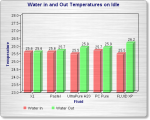 |
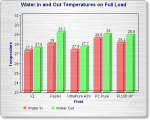 |
As one can see all the above temperatures on idle are roughly the same-barring Fluid XP; however at full CPU load then the results become more profound. The X1 product of the Mayhems range performs really well and is overall ahead of the rest, however next comes the Ultra pure H20. What is most impressive is that the X1 performs so close to distilled water that overall there is little or no difference between them. After this is the PC Pure, however in this review and in this test in particular we shall place Primochill’s product in second place. The reason for this is that though the overall results shown here are not as impressive as the ‘H20 ultra Pure’ from mayhems, this was used ‘neat’ and had no biocides within the fluid, whilst PC Pure does. So to avoid being unfair we are using the ‘ultra Pure H20′ for comparison purposes only. After this we have the Fluid XP product and lastly the Pastel range of Mayhem’s.
Looking at the above then it must be noted that with the pastel there is a massive temperature differential between the input and out of the fluid at full load. This indicates that if one wishes to use high end graphics cards with extreme overclocking then this may not be your ideal solution if performance temperature is your goal as this will stress the fluid even more than what we have done here. However, in all fairness the literature on their sites states that this fluid is for ‘looks and modding only’ and if one wanted performance then they better look more towards the X1 and the Ultra Pure H20 range. Fluid XP however cannot lay this claim, and for a bottle that costs fifteen pounds per litre, in all honesty it is quite unforgivable.
For reference purposes below are the air in and air out for the radiator on all fluid tests.
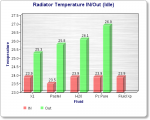 |
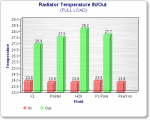 |
Edit: we forgot to add the radiator out temperatures for FluidXp at idle and on full load and these are 27.9 and 28.9
Before we get to the all important CPU temperature results we shall have a little note about the filling and bleeding of the system on each fluid.
- Mayhem’s X1 The viscosity feels roughly the same as of water and the bleeding of air bubbles was exactly the same of the latter mentioned.
- Mayhem’s Pastel Feels the same as the X1 however for some reason I had to spend time getting all the larger air bubbles out
- Ultra Pure H20 and PC Pure as with all water of the same time, and bubble removal was a simple affair.
- Fluid XP this product feels almost like motor oil and air bubble removal was a trial and took around two hours to complete.
The charts below show the all important CPU test results:
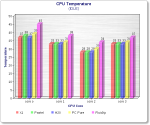 |
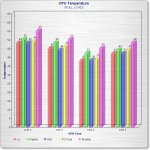 |
Once again an impressive result shown by the X1 product from Mayhem’s with very little or no difference even on full load. Looking at the results of the pastel on idle we can see that the base liquid of the former mentioned must be (pardon the pun) based upon the X1 range. However, though at full load the temperature differences are large at around four degrees worse than the X1. The Primochill does really well since it is essentially only water with glycol added. The Promichill and Ultra Pure difference could be explained due to the lack of a biocide in one of the products and as such would be unfair to compare the two. However, facts are facts and judging by the data at hand the Primochill PC Pure certainly performs well. What is disappointing is again the FluidXp results. We would like to think that this was due to viscosity of the fluid and the combined XSPC 750 Res/pump is unable to cope. However, if we factor in an old Thermochill XSPC EC6 fluid review and the testing on this was with a separate pump and still it achieved the worst results of the bunch by far, then the question begs to be offered ‘Why is FLUID XP still selling?’
To round up the two top performing liquids, these would be the X1 and by a respectful margin Primochill’s PC Pure. Respect is due to X1 from Mayhems as it is not water-based unlike the Primochill’s offering.
Next we can finally move onto the conclusion of this review.

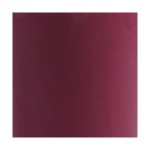




 Posted in
Posted in 

